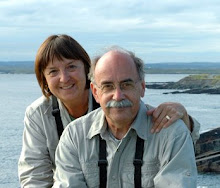We have now been birding for a solid week. To date, as a group, we have tallied nearly 300 bird species so far – 33 of them hummingbirds. In addition to our daily excitement of adding new birds, we also have enjoyed repeated looks at birds we have already seen. After all, this is a bird watching tour, not simply an exercise in math.
As planned the night before, we assembled before daybreak around the lodge’s swimming pool to try for the Western Peruvian Pygmy-Owl. Richard had again heard one calling around 2:00 in the morning from his balcony. As the group jockeyed in the dark, Jim took one step too many backward toward the pool. Splash! There was Jim fully-clothed, treading water. His first words, "Don't worry - I'm an excellent swimmer!" Thank goodness his binoculars were waterproof! Of more concern were his hiking boots and trying to get them dried. Alas, Jim's unexpected plunge in the pool was for naught as the owl never responded to José's recording.
With Jim in dry clothing, we found ourselves on the bus headed back to Tapichalaca. Our plan was to re-hike part of the trail we navigated the previous day to try again for a quail-dove and a tinamou.
Back at Tapichalaca, Carol, Claire, and Rita elected to stay back near the bus feeling that the group’s size was going to preclude everyone from seeing the target birds, plus, they didn’t feel up to negotiating the muddy trail. The rest of us forged on. After walking beyond the trailhead along a dirt rut road for an hour, we returned and started up the trail.
As with the day before, we approached the hide one at a time. A few would stay in the blind while others came and went. I had briefly seen the quail-dove the day before on the trail but being last in the group to get into the hide, just missed the tinamou. But then that’s the way it goes – not everyone got to see everything.
Meanwhile back at the bus, Carol, Rita and Claire had picked up a new hummingbird while on their own walkabout: Rufous-capped Thornbill. They also had good looks at a Barred Fruiteater.
We ate our box lunch again on the lodge's porch while watching the hummingbird feeders. New at the feeders for the day: Buff-winged Starfronlet.
A bit of journal catch-up: During lunch the day before, Niko and José had left the group. When they reappeared it was with two other men carrying boxes of what appeared to be parts for a new air conditioner. We assumed they were helping with the delivery of equipment to be installed at the lodge. Not exactly. It turned out that a car had plunged off the road immediately below the lodge. The equipment we saw them carrying had been retrieved from the wreckage.
Investigating the crash site we barely saw the remains of a vehicle lodged 100 or more feet nearly straight below in thick vegetation. The saving grace for the driver and passenger was that the car had become wedged in tree branches, which had kept the vehicle from tumbling a lot further. Amazingly, neither of them appeared hurt. They sustained only scratches but the car was a total loss. When the accident happened, we never heard a sound! It was believed that during a straight-through drive from Guayaquil, the driver had fallen asleep - in broad daylight - and swerved off the road. It was fortunate that the car left the road where it had as opposed to 50 feet further where it would have dropped straight off of a cliff. Given the amount of effort and expense to retrieve the car, it was going to be left for the jungle to reclaim it (after gas and oil had been drained and parts scavenged). In a week, all visible signs of the car from the road would vanish.
After our afternoon walk down the road, Niko picked us up and we headed back to the Hosteria Izhcayluma. New birds added during our morning trail walk and afternoon roadside birding include: Bearded Guan, White-capped Parrot, Scaly-naped Amazon (flyover), Rufous Spinetail, Streaked Tuftedcheek (heard only), Rufous Antpitta (heard only), nice looks at a very cooperative Chusquea Tapaculo, Slaty-backed Chat-Tyrant, Yellow-bellied Chat-Tyrant, knockout look at Barred Fruiteater, Rufous Wren, Citrine Warbler, Capped Conebill, Glossy Flowerpiercer, Golden-crowned Tanager, Páramo Seedeater.
We arrived back at the hosteria in daylight. What a nice trend! A few local artists had arrived and set up tables laden mainly with hand-made jewelry. Melissa and Risé lost no time picking out treasures, as did the rest of the group when they discovered the shopping opportunity.
Richard suggested that we try again for the pygmy-owl from his room’s balcony (well away from the pool). José’s recording was finally successful in calling in the owl. Flooded with José's powerful spotlight, we all got great looks before the bird discovered the deception and disappeared.
Today's checklist, as it was pointed out to Richard, included a very “special bird” seen by all early in the morning: a White-capped Dipper. Jim took the ribbing well (specially since it was Naomi who had suggested the name owing to Jim’s white head of hair). The joke of course was that there really IS a bird in Ecuador called a White-capped Dipper.
José reminded us that we would be moving on in the morning and to have our bags packed and ready to be loaded onto the bus when we came down for breakfast. Next up: the "rustic" Copalinga Lodge outside of Zamora in Zamora-Chinchipe Province.



No comments:
Post a Comment